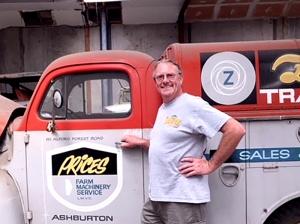Search

 Tony Price was pleased to discover the old work truck had been saved by a Christchurch collector. Photo supplied.Tony Price, former wild child, was made for the Nascar racing scene.
Tony Price was pleased to discover the old work truck had been saved by a Christchurch collector. Photo supplied.Tony Price, former wild child, was made for the Nascar racing scene.
The former Ashburton man once had long hair and ran with bikers; given the chance, he would probably have driven the fast cars in America that ferried illegal moonshine in the 1930s.
Those cars, souped up to avoid the federal tax agents who tried to bust them, are part of Nascar’s folklore history.
By the 1940s, the moonshine runners’ informal races had become an organised sport with rules and a growing following.
Price, who grew up repairing farm tractors in his father’s machinery workshop on Alford Forest Road, has worked his way up from mechanic to pit boss and beyond for the American Roush Fenway Racing, which has just begun its 31st season of Nascar competition.
Roush Fenway is the most successful team in Nascar history and Price has been a big part of that.
He was back in Mid Canterbury recently on family business and happy to talk about his life in the fast lane.
Price went to Ashburton College in the 1970s but says he was a wild child and the classroom was not a natural habitat.
He left at 16 for an mechanic’s apprenticeship with Burnett Motors.
The work was easy for him after spending his younger years working alongside father Keith in his farm machinery business in Ashburton.
While he was being groomed to one day take over the business, the big, slow farm vehicles held no interest for him.
He yearned for speed and his mates had fast cars and motorbikes.
Advanced as a mechanic, he then worked for Smallbones, where he finished his apprenticeship.
He remembers learning a few tricks in the workshop from Ross Proctor and Ross Higgins, who now owns a Harley-Davidson franchise in Thailand.
In 1976, Price decided to chance his arm in Australia building racing car engines and discovered he had a knack for it.
There, he got to know a few American racers and worked on their saloon and sprint cars. Come over to the States, they said. Eventually he did.
He started building race cars and engines with them, winning races all over California and Oregon.
With his reputation growing, he was eventually approached by one of the Nascar racing teams and in 1985 packed up his truck and headed to Charlotte, North Carolina.
Price hit the Nascar headlines as part of a hastily-picked crew that pitted the winner of the Daytona International 400 that year.
Pit crews are like athletes, repeatedly practising jacking up cars, changing tyres and fuelling the machine, to shave seconds off their times – a winning crew put together at the last minute was unheard of.
Price was crewing for Greg Sacks, who was driving an experimental Chevrolet the talented young Kiwi mechanic had been working on quietly, living, working and sleeping in the workshop to get the job done.
“I prepared the car, it won at Daytona with Greg at the wheel.
“That was unheard of.”
It was also the start of a 33-year relationship in the incredibly competitive business of Nascar racing.
Jack Roush, a former Ford engineer and college physics teacher, lured him over to work on his road racing cars, but he really wanted to start a Nascar team.
Price was his man.
Price’s basic training as a mechanic meant he could deal with all aspects of the car.
Later he would concentrate on building the race cars, while another expert took care of the engines.
He did the rounds of race teams for a couple of years and in the 1990s he teamed up with Roush again.
He was in charge of six racing teams under the Roush racing umbrella. Each team had 13 cars and a crew of specialists.
Race cars are an expensive business: Each of the six teams ran 13 cars, new cars were required every race and there were 36 races a year.
Price said cars cost around $100,000 without an engine, which was $90,000.
The 940hp engines are specially made for the car racing industry and made by Roush’s company; they run on a special mix of unleaded petrol and are built for racing at more than 200 miles per hour (around 320km/h).
Compare this power to the 110hp Toyota Corolla in your driveway.
Price said it became his job to rationalise the operation, to look for ways to save money.
Teams would go on to share specialists and reduce crew numbers.
Price said other things had changed on the Nascar scene in the past 30 years too.
Teams now fly to races, instead of trucking 12 hours each way.
The grandstands are also not as full, but there’s better TV coverage.
Price was in New Zealand as the first qualifying races for Daytona got under way and the season will continue to November.
When he’s not at the track, Price enjoys older cars, especially the 1936 Ford he bought at 17 and restored.
He had it shipped to the States, where he lives with his wife Cindy of 32 years; the couple have two daughters, Laura, a dental assistant, and Kilee, an artist.
On this last trip home, he had the pleasure of taking his father to see one of their old work vehicles, which has been bought and stored by a Christchurch enthusiast.
It was part of celebrations to mark Keith’s 90th birthday.
By Linda Clarke © The Ashburton Guardian - 24 February 2018

